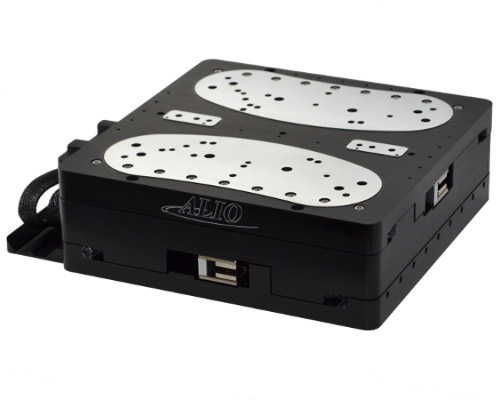Industries that rely on motion control are demanding faster and more accurate control systems for their applications. The semiconductor and medical industries in particular require ever increasing speed and precision for inspection and diagnostic purposes. Fast system response coupled with nanometer range positioning requires careful design and implementation. Manufacturers working to meet these requirements face higher costs and longer development times as a result. By supplying cutting edge hardware and system analysis tools, Galil takes the guess work out of servo system design and tuning, allowing developers to bring superior products to market faster.
The Galil Applications Team recently worked with an XY linear stage from ALIO Industries, featuring linear servo motors and 50 nanometer encoder feedback. The application required moving each axis a distance of 100 μm with positioning error of ± 0.25 μm and a move/settle time of 30 ms, allowing data collection at 30 Hz. These requirements demand a motion controller capable of high bandwidth servo update rates, advanced PID tuning capabilities and high resolution command signals.
Galil's flagship DMC-4000 series motion controller and internal amplifiers constitute a powerful hardware platform allowing for pin point motion control. The DMC-4020 can attain servo update rates as high as 16 kHz while simultaneously handling coordinated motion profiles, monitoring IO, and communicating with a host PC. The D3520 internal servo amplifier is software configurable, allowing optimal matching of gain and current loop bandwidth with motor specifications. This, in addition to sinusoidal commutation, make the D3520 a superb choice for smooth and precise motion profiles.
With the hardware appropriately connected and configured, the process of system analysis and tuning was performed using Galil's software tools. This is a two step process of characterizing the open loop bandwidth of the system and using that data to select the servo update rate in addition to PID parameters that provide the required motion profiles.
First, a 5 - 300 Hz open loop frequency sweep was performed on each axis, injecting a sine wave into the axis control signal. Using this method, open loop bandwidths were found to be 274 Hz and 158 Hz for the X and Y axes respectively. Higher bandwidths correspond with faster response times and the lower bandwidth of the Y axis is a result of its carrying the mass of the X axis stage. A rule of thumb for servo systems advises update rates of at least 10 times the system bandwidth. Given this information, a servo update rate of 4 kHz was chosen and set via software using Galil's two letter, English-like commands.
Next, Galil tuning software was used to auto select and test PID gain values. These values are (by design) on the conservative side, favoring stability over response time. The benefit however is that the majority of manual tuning is greatly reduced since most of the heavy lifting associated with tuning from scratch is taken care of by Galil software. The remaining tuning was done using Galil communications software to set PID gains on the fly and monitor system response via real time plots of the command, feedback, and error signals. Response curves for the tuned system are shown below in figure 1.

This process yielded a 274 Hz crossover frequency with 44 degrees of phase margin for the X axis and 158 Hz crossover frequency with 46 degrees of phase margin for the Y axis, both in very close proximity to the ideal, critically damped servo response. As a result, the system was able to achieve the desired motion profile well within the specified tolerances. Moves of 100 microns were performed at a 30 Hz rate with settling times of less than 1 ms and positioning error of ± 150 nanometers (3 counts). Additional testing with servo update rates as high as 16 kHz showed no noticeable performance boost.
Any system is only as strong as its weakest component and for applications requiring high speed and precision, there is little margin for error. Galil hardware and system analysis tools allow for quicker development cycles and solid performance that can help ensure quality. This combined with unparalleled product support make Galil motion controllers a superior choice for the most demanding motion control applications.
For more technical information regarding this particular application and tuning, please refer to Application Note 5527 on our website, www.galil.com.


